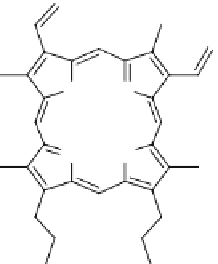Biomedical Engineering Reference
In-Depth Information
NH
N
N
HN
O
O
N
N
O
O
O
O
H
2
N
NH
2
PpIX PpIX
Fig. 25
PpIX-modified pores of MSN (Reproduced by permission of The Royal Society of
Chemistry)
Mou and collaborators have reported conjugation of PpIX (Fig.
7
) with MSN
through covalent bonding to yield PpIX-modified MSN (Fig.
25
) for PDT studies
(Tu et al.
2009
).
These particles were obtained by using classic MCM-41 type direct microemul-
sion synthesis, leading to 110 nm diameter objects. The MSN were then functional-
ized with 3-aminopropyltrimethoxysilane, allowing the grafting of activated PpIX
(Fig.
7
). The porous nature of the particles lead to site-isolation of the PS which
avoided self-quenching of aggregated PpIX. The absorption spectrum of the
PS-grafted nanoparticles was similar to that of the free PpIX, showing no change of
the chromophore upon entrapment in the MSN. Moreover, samples of PpIX grafted
to MSN were shown to have a better integrity under laser irradiation compared to
free PpIX.
1
O
2
generation was checked both by monitoring the
1
O
2
luminescence and
by using DPBF as a detector. Dark cytotoxicity was estimated for HeLa cells and
the cell viability was not affected at dosage up to 80 mg/mL. Uptake of the PpIX-
modified particles by HeLa cells was quite efficient (higher than 70% for 20-80 mg/
mL concentrations after a total of 6 h incubation). Phototoxicity was evaluated after
a 6 min tungsten lamp irradiation (115 mW/cm
2
, 80 mg/mL). Both concentration-
and irradiation time-dependent cell viability were observed. Depending on the tested
concentration, both necrosis and apoptosis process could be observed.



































Search WWH ::

Custom Search